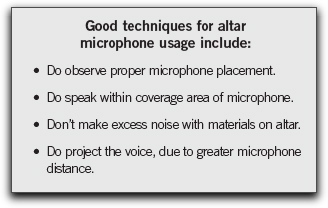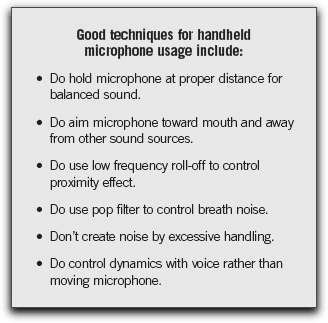
Altar
The desired sound source for an altar application is a speaking (or sometimes singing) voice.
Undesired sounds may include direct sounds, such as choir, organ, or loudspeakers and ambient noise sources, such as building noise or the congregation itself.
A boundary microphone is the physical design best suited to this application.
Its use will minimize interference effects due to reflections from the altar surface and will also result in increased microphone sensitivity. A condenser type is the most effective for this configuration, due to its high performance and small size.
The frequency response should be optimized for the vocal range and will benefit from a slight presence rise.
A unidirectional (typically cardioid) pattern will give the broadest coverage with good rejection of feedback and noise. A condenser microphone will provide the highest sensitivity. Finally, the microphone should have a balanced low-impedance output.
The microphone should be placed flat on the altar at a distance of 2 to 3 feet and aimed towards the normal position of the person speaking. It should be located or aimed away from other objects and from any local noise such as page turning. Unless there is more than one distinct position to be covered, and unless these positions do not violate the 3-to-1 rule, use only one altar microphone.
The microphone should be connected and powered (if a condenser) in the proper fashion. If the altar itself is a source of noise or vibration, isolate the microphone from it with a thin foam pad. A low-frequency filter may be a desirable or even necessary feature. A pop filter is not normally required. Do not cover the microphone with heavy altar linens.

Handheld Vocal
The desired sound source for a handheld microphone is a singing or speaking voice. Undesired sounds may include other singers, musical instruments, and various ambient sounds. In addition to the normal loudspeakers, the sound system may also have nearby “monitor” speakers aimed toward the singer.
Suitable microphone performance for this application can be provided by dynamics or condensers. Due to frequent handling and the potential for rough treatment, dynamic microphones are most often used, though durable condensers are available for high-performance applications. The preferred frequency response is shaped: vocal range, with presence rise for intelligibility and low-frequency roll-off for control of proximity effect and handling noise.
These microphones should always be unidirectional: a cardioid pattern is most common, while supercardioid and hypercardioid types may be used in difficult noise or feedback situations. Balanced, low-impedance output configuration is standard, while adequate sensitivity may be achieved with dynamic or condenser types.
Finally, the physical design is optimized for comfortable handheld use, and generally includes an integral windscreen/pop filter and an internal shock mount. An on-off switch may be desirable in some situations.
Positioning a handheld microphone at a distance of 4 to 12 inches from the mouth (and aimed towards it) will give good pickup of the voice. In addition, locating the microphone slightly off-center, but angled inward, will reduce breath noise.
With high levels of sound from adjacent musical instruments or other singers, it may be necessary to hold the microphone closer to the mouth. If the distance is very short, especially less than 4 inches, proximity effect will greatly increase the low-frequency response. Though this may be desirable for many voices, a low-frequency roll-off may be needed to avoid a boomy sound. Additional pop filtering may also be required for very close use.
Use of rugged, flexible cables with reliable connectors is an absolute necessity with handheld microphones. A stand or holder should also be provided if it is desirable to use the microphone hands-free.

(Copyright Shure Incorporated, used by permission.)

